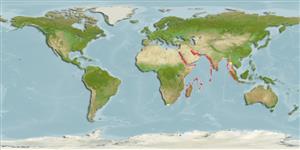Common names from other countries
Environment: milieu / climate zone / depth range / distribution range
Ökologie
seewasser riff-verbunden; tiefenbereich 0 - 85 m (Ref. 104785). Tropical; 30°N - 36°S, 19°E - 112°E
Indian Ocean: Persian Gulf (Ref.80050) and Red Sea south to Port Alfred, South Africa and east to Sumatra, Indonesia (Ref. 33390). Atlantic Ocean. Also known in eastern Mediterranean (Ref. 37421).
Size / Gewicht / Alter
Maturity: Lm ? range ? - ? cm
Max length : 43.0 cm TL Männchen/unbestimmt; (Ref. 125962)
Rückenflossenstacheln (insgesamt) : 13; Rückenflossenweichstrahlen (insgesamt) : 9 - 11; Afterflossenstacheln: 3; Afterflossenweichstrahlen: 6 - 7. Reddish to tan or grey in color, with numerous thin dark bars on body and head; tentacle above eye may be faintly banded (Ref. 4313). Adults have a band of small spines along the cheek and small spots in the median fins (Ref. 48635).
Adults are found in coastal waters in muddy habitats (Ref. 48635). Minimum depth of 0m (Ref. 81209). Fin spines highly venomous, may cause human death (Ref. 30573).
Life cycle and mating behavior
Maturities | Fortpflanzung | Spawnings | Egg(s) | Fecundities | Larven
Eschmeyer, W.N., 1986. Scorpaenidae. p. 463-478. In M.M. Smith and P.C. Heemstra (eds.) Smiths' sea fishes. Springer-Verlag, Berlin. (Ref. 4313)
IUCN Rote Liste Status (Ref. 130435)
CITES (Ref. 128078)
Not Evaluated
Nutzung durch Menschen
Fischereien: kommerziell; Aquarium: Kommerziell
Tools
Zusatzinformationen
Download XML
Internet Quellen
Estimates based on models
Preferred temperature (Ref.
115969): 24.5 - 29.3, mean 27.6 (based on 328 cells).
Phylogenetic diversity index (Ref.
82804): PD
50 = 0.5005 [Uniqueness, from 0.5 = low to 2.0 = high].
Bayesian length-weight: a=0.01175 (0.00645 - 0.02141), b=3.02 (2.86 - 3.18), in cm Total Length, based on LWR estimates for this species & (Sub)family-body (Ref.
93245).
Trophic level (Ref.
69278): 4.5 ±0.80 se; based on food items.
Widerstandsfähigkeit (Ref.
120179): niedrig, Verdopplung der Population dauert 4,5 - 14 Jahre. (Preliminary K or Fecundity.).
Fishing Vulnerability (Ref.
59153): Low to moderate vulnerability (33 of 100).
